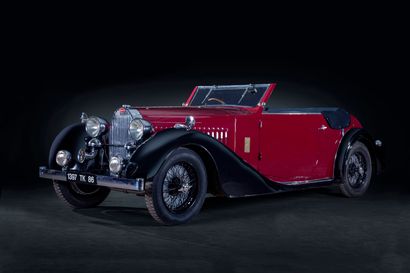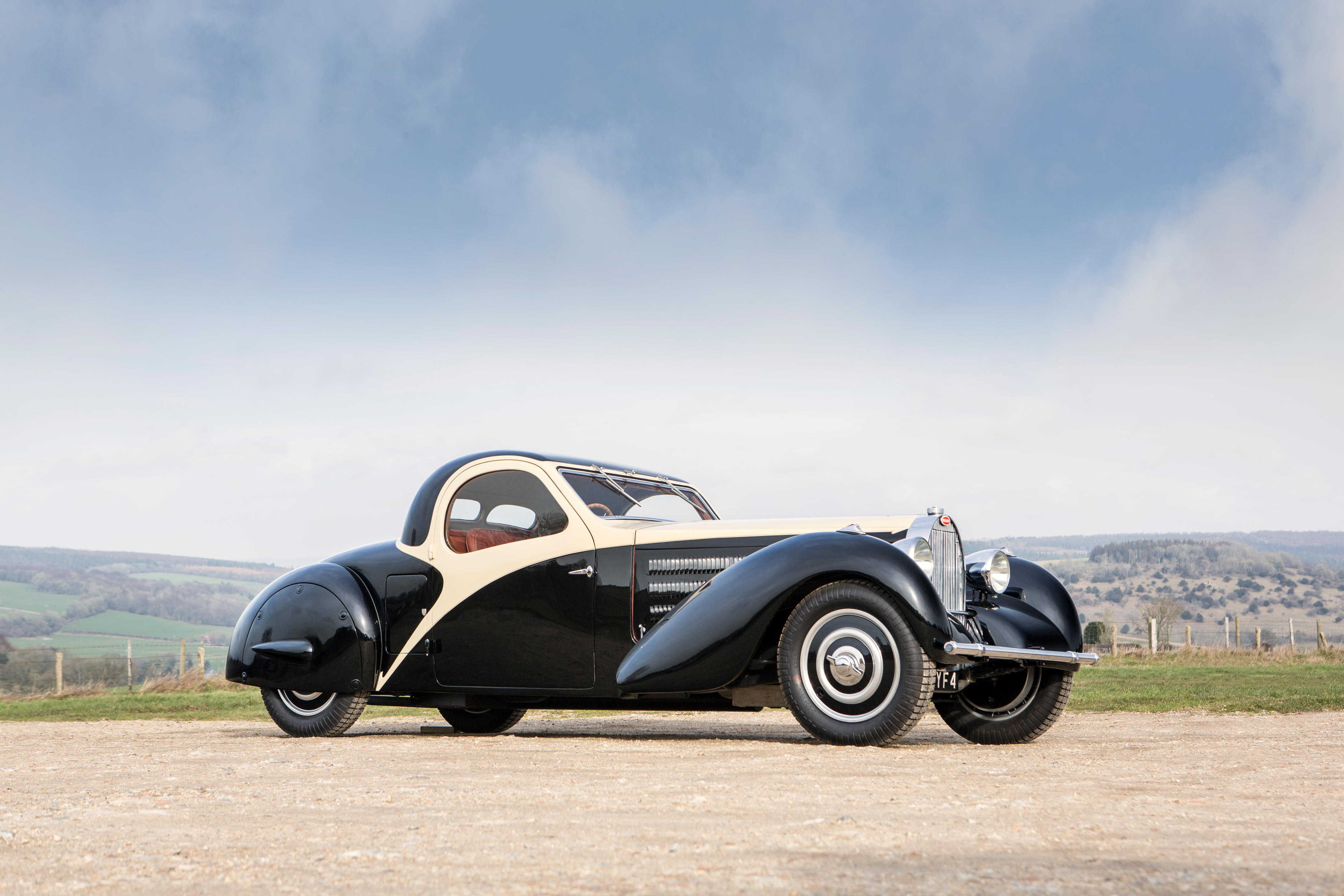3,257cc DOHC Inline 8-Cylinder Engine Dual Throat Updraft Stromberg Carburetor 135bhp at 5,500rpm 4-Speed Manual Transmission 4-Wheel Cable Operated Drum Brakes *A handsome and inviting Type 57 benefitting from recent expert care *Known history from the 1970s *Elegant Jean Bugatti designed coachwork with an appealing patina *Wonderfully suited for Bugatti Club road events THE BUGATTI TYPE 57 The Type 57 Bugatti, introduced in 1934, marked Jean Bugatti's emergence as Bugatti's leader and creative force. It was the first new model built under his direction and it incorporated many features new to Bugatti. Its dual overhead camshaft eight-cylinder engine had dimensions of 72x100mm, offering 3,257cc displacement. The crankshaft ran in five main bearings. The camshafts were driven by a train of helical-tooth gears at the engine's rear with a further crankshaft bearing behind them. Finger cam followers minimized side thrust on the valve stems. The Type 57 also marked Bugatti's first use of a transmission fixed to the engine crankcase and a single plate clutch. The top three gears in the four-speed gearbox were constant mesh. Jean created a novel independent front suspension system using transverse leaf springs for the first two examples of the Type 57 before Le Patron spied it and insisted it be replaced by a proper Bugatti hollow tubular live axle. Thenceforth suspension was traditional Bugatti semi-elliptical front and reversed quarter-elliptical rear leaf springs with cable-operated mechanical drum brakes. Much of the Type 57's commercial success may be attributed to Jean Bugatti's sensitive, flowing coachwork which graced the most famous of the chassis' examples. Atalante two-seat coupé, Ventoux four-seat coupé, Stelvio cabriolet and the Galibier sedan vied with the best of France's and Europe's formidable coachbuilders' creations and comprised the bulk of Type 57 production. Bugatti's clients could have the best, but overwhelmingly they chose Jean Bugatti's designs on the Type 57. Despite financial travail, development of the Type 57 continued with introduction of a stiffened frame and rubber-mounted engine along with the supercharged 160hp Type 57C in 1936. In 1938 the nearly unthinkable happened in Molsheim when Bugatti finally adopted Lockheed hydraulically actuated brakes and replaced the beautiful and lightweight but expensive aluminum-spoked wheels and brake drums with Rudge-Whitworth center-lock wire wheels and separate brake drums. THE MOTORCAR OFFERED This 1935 Bugatti Galibier Saloon, is a handsome and usable example that is wonderfully suited for touring in the grand tradition of the Bugatti T57. It has been treated to recent mechanical care courtesy of a West Coast specialist and is presented with a charming patina that encourages enjoyment on the road. According to the car's history file and correspondence with American Bugatti specialists, it is based on an early Series 1 chassis and running gear, while the body originates from a later Series II car. Such combinations are not uncommon in the Bugatti world, as many cars were separated from their original coachwork during WWII or utilized for parts over the years. Little is known of this car's earliest history, though it is understood that this Galibier body came from a later chassis. In the 1970s, the Bugatti was in France, owned by Adrien Maeght. Mr. Maeght was part of a famous family of art dealers and patrons, who maintained a spectacular collection of artworks, held across galleries in Paris and Barcelona, and Nice. In addition to priceless works of art, Adrien collected automobiles, with a particular fondness for Bugattis. He maintained a private motoring museum, and he published Antoine Raffaelli's fabulous book, Memoirs of a Bugatti Hunter. A copy of a French registration in Maeght's name is included in the history file. It was sold from the Maeght collection in 1994, purchased by A. Arman, also of France, who preceded two additional short-term owners. By 20
3,257cc DOHC Inline 8-Cylinder Engine Dual Throat Updraft Stromberg Carburetor 135bhp at 5,500rpm 4-Speed Manual Transmission 4-Wheel Cable Operated Drum Brakes *A handsome and inviting Type 57 benefitting from recent expert care *Known history from the 1970s *Elegant Jean Bugatti designed coachwork with an appealing patina *Wonderfully suited for Bugatti Club road events THE BUGATTI TYPE 57 The Type 57 Bugatti, introduced in 1934, marked Jean Bugatti's emergence as Bugatti's leader and creative force. It was the first new model built under his direction and it incorporated many features new to Bugatti. Its dual overhead camshaft eight-cylinder engine had dimensions of 72x100mm, offering 3,257cc displacement. The crankshaft ran in five main bearings. The camshafts were driven by a train of helical-tooth gears at the engine's rear with a further crankshaft bearing behind them. Finger cam followers minimized side thrust on the valve stems. The Type 57 also marked Bugatti's first use of a transmission fixed to the engine crankcase and a single plate clutch. The top three gears in the four-speed gearbox were constant mesh. Jean created a novel independent front suspension system using transverse leaf springs for the first two examples of the Type 57 before Le Patron spied it and insisted it be replaced by a proper Bugatti hollow tubular live axle. Thenceforth suspension was traditional Bugatti semi-elliptical front and reversed quarter-elliptical rear leaf springs with cable-operated mechanical drum brakes. Much of the Type 57's commercial success may be attributed to Jean Bugatti's sensitive, flowing coachwork which graced the most famous of the chassis' examples. Atalante two-seat coupé, Ventoux four-seat coupé, Stelvio cabriolet and the Galibier sedan vied with the best of France's and Europe's formidable coachbuilders' creations and comprised the bulk of Type 57 production. Bugatti's clients could have the best, but overwhelmingly they chose Jean Bugatti's designs on the Type 57. Despite financial travail, development of the Type 57 continued with introduction of a stiffened frame and rubber-mounted engine along with the supercharged 160hp Type 57C in 1936. In 1938 the nearly unthinkable happened in Molsheim when Bugatti finally adopted Lockheed hydraulically actuated brakes and replaced the beautiful and lightweight but expensive aluminum-spoked wheels and brake drums with Rudge-Whitworth center-lock wire wheels and separate brake drums. THE MOTORCAR OFFERED This 1935 Bugatti Galibier Saloon, is a handsome and usable example that is wonderfully suited for touring in the grand tradition of the Bugatti T57. It has been treated to recent mechanical care courtesy of a West Coast specialist and is presented with a charming patina that encourages enjoyment on the road. According to the car's history file and correspondence with American Bugatti specialists, it is based on an early Series 1 chassis and running gear, while the body originates from a later Series II car. Such combinations are not uncommon in the Bugatti world, as many cars were separated from their original coachwork during WWII or utilized for parts over the years. Little is known of this car's earliest history, though it is understood that this Galibier body came from a later chassis. In the 1970s, the Bugatti was in France, owned by Adrien Maeght. Mr. Maeght was part of a famous family of art dealers and patrons, who maintained a spectacular collection of artworks, held across galleries in Paris and Barcelona, and Nice. In addition to priceless works of art, Adrien collected automobiles, with a particular fondness for Bugattis. He maintained a private motoring museum, and he published Antoine Raffaelli's fabulous book, Memoirs of a Bugatti Hunter. A copy of a French registration in Maeght's name is included in the history file. It was sold from the Maeght collection in 1994, purchased by A. Arman, also of France, who preceded two additional short-term owners. By 20














Testen Sie LotSearch und seine Premium-Features 7 Tage - ohne Kosten!
Lassen Sie sich automatisch über neue Objekte in kommenden Auktionen benachrichtigen.
Suchauftrag anlegen